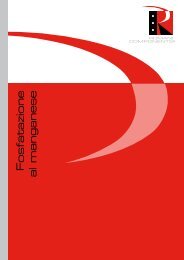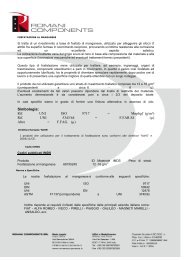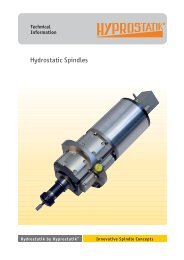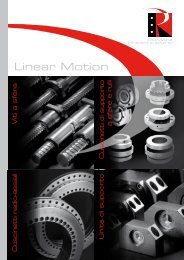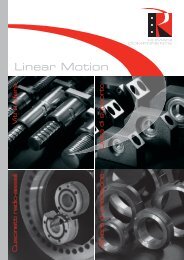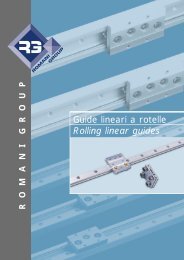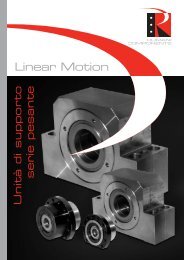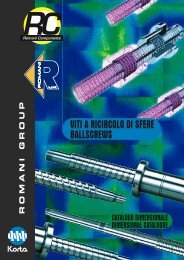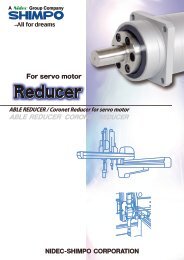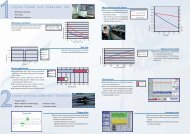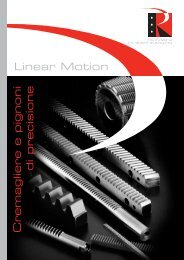catalogo tecnico technical catalogue - Romani Components
catalogo tecnico technical catalogue - Romani Components
catalogo tecnico technical catalogue - Romani Components
Create successful ePaper yourself
Turn your PDF publications into a flip-book with our unique Google optimized e-Paper software.
os tienen un rendimiento elevadísimo que<br />
puede llegar en algunos casos hasta cotas del<br />
97% y 98%.<br />
En la figura 5 se muestran dos gráficos en<br />
los que se puede apreciar la gran diferencia<br />
existente entre los rendimientos obtenidos con<br />
los husillos a bolas, en oposición con los rendimientos<br />
de los convencionales.<br />
η (%)<br />
1<br />
100<br />
90<br />
80<br />
70<br />
60<br />
50<br />
40<br />
30<br />
20<br />
10<br />
µ=0,003<br />
µ=0,005<br />
µ=0,01<br />
Husillos a bolas<br />
Ball screw<br />
µ=0,1<br />
µ=0,2<br />
Husillo convencional<br />
Conventional screw<br />
Rendimiento η (%)<br />
2<br />
Efficiency<br />
much higher, in some cases as much as 97%<br />
and 98%.<br />
Figure 5 shows two charts giving a good<br />
idea of the higher rates of efficiency achieved<br />
when using ball screws as opposed to the use<br />
of conventional screws.<br />
100<br />
90<br />
80<br />
70<br />
60<br />
50<br />
40<br />
30<br />
20<br />
10<br />
µ=0,003<br />
µ=0,005<br />
µ=0,01<br />
Husillos a bolas<br />
Ball screw<br />
Husillo convencional<br />
Conventional screw<br />
µ=0,1<br />
µ : Coeficiente de rozamiento<br />
µ : Friction coeficient<br />
0 1 2 3 4 5 6 7 8 9 10<br />
ϕ(º) Angulo de Hélice ( Grados )<br />
ϕ(º) Lead angles ϕ (Degrees) (º)<br />
Uso Uso normal: Conversión del movimiento<br />
de de rotación en en movimiento lineal.<br />
Normal use: use: transformation of of a rotary<br />
motion<br />
motion<br />
into<br />
into<br />
a linear<br />
linear<br />
motion.<br />
motion<br />
0 1 2 3 4 5 6 7 8 9 10<br />
Angulo de Hélice ( Grados )<br />
ϕ (º)<br />
Uso normal: Conversión del movimiento<br />
lineal Uso especial: en movimiento Conversión de rotación. del movimiento<br />
lineal Normal en use: movimiento transformation de rotación. of a rotary<br />
motion Special into use: a linear transformation motion of a linear<br />
µ: motion Coeficiente into a de rotary rozamiento. motion.<br />
µ: Friction coefficient<br />
Fig. 5. Rendimiento mecánico de los husillos a bolas KORTA<br />
Mechanical efficiency of KORTA ball screws<br />
Todas estas características descritas,<br />
hacen que los husillos a bolas tengan<br />
una gran duración, a la vez que proporcionan<br />
gran precisión de movimiento y posicionamiento.<br />
También, permiten velocidades de traslación<br />
muy superiores con respecto a los husillos convencionales<br />
de fileteado trapezoidal, menores<br />
vibraciones, deslizamientos, desgastes, calentamientos,<br />
y en definitiva menores potencias de<br />
arrastre. Por todo ello, asegura una elevada<br />
calidad en la fabricación del producto,<br />
para de esta manera, garantizar todas las ventajas<br />
descritas en favor de los husillos a bolas.<br />
El contacto con metal en un husillo convencional<br />
necesita una alta fuerza de puesta en<br />
marcha debido al rozamiento. Por el contrario,<br />
las bolas del husillo necesitan una pequeña<br />
fuerza para superar el rozamiento de rodadura.<br />
All those characteristics contribute to<br />
ensure the long service life of ball<br />
screws and their working with high positioning<br />
and motion accuracy. They also allow transfer<br />
speeds much higher than are obtained with<br />
conventional trapezoidal thread screws. Other<br />
interesting features are fewer vibrations and<br />
displacements, less wear and overheating and,<br />
finally, lower drive powers. To achieve this and<br />
to guarantee the described advantages of ball<br />
screws, cares for top quality throughout<br />
the product manufacturing process.<br />
Because of their metal-against-metal contact<br />
and subsequent sliding friction, conventional<br />
screws require a high initial driving force.<br />
By contrast, only a small force is needed by the<br />
balls of a ball screw to overcome the rolling<br />
friction.<br />
9



